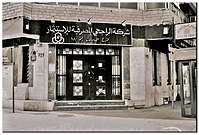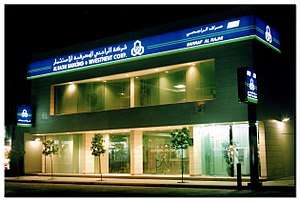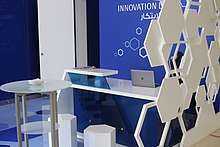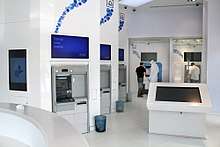Al-Rajhi Bank
 | |
| Public (Tadawul: 1120) | |
| Industry | Banking, financial services |
| Founded | 1957 |
| Headquarters | Riyadh, Saudi Arabia |
Number of locations |
600+ Branches 4,700+ ATMs 73,000+ POS |
Key people | |
| Products | Financial Services |
| Revenue |
|
|
| |
|
| |
| Total assets |
|
| Total equity |
|
Number of employees |
|
| Divisions | Tahweel Al Rajhi |
| Subsidiaries |
Al Rajhi Capital Al Rahji Takaful Agency Al Rajhi Development Company Al Rajhi for Administrative Services Company |
| Rating | A1 (Moody's)[3] |
| Website | www.alrajhibank.com.sa |
The Al Rajhi Bank (Arabic: مصرف الراجحي) (previously known as Al Rajhi Banking and Investment Corporation)[4] is a Saudi Arabian bank and the world's largest Islamic bank by capital based on 2015 data.[5]
The bank is Saudi Arabia's largest bank by market value[6] and the Kingdom's second largest lender[7] with over SR 330.5 billion in AUM ($88 billion)[8] and over 600 branches.[9] Its head office is located in Riyadh, with six regional offices. Al Rajhi Bank also has branches in Kuwait and Jordan, and a subsidiary in Malaysia.
History

Foundation
In 1957, the first men's branch was opened in Aldirah by four brothers, Sulaiman, Saleh, Abdullah, and Mohamed, of the Al Rajhi family, one of the wealthiest families in Saudi Arabia.
The bank initially began as a group of banking and commercial operations, which in 1978, joined under the umbrella of the Al Rajhi Trading and Exchange Company.
The first ladies branch opened in AlShmaisi in Riyadh in 1979.

Joint stock
In 1987, the company turned into a Joint Stock Company under the royal decree no. (59) and Al-Rajhi Banking and Investment Saudi Joint Stock Company was announced under the ministerial resolution no. (1398). It was in 1988 that the bank established as a Saudi shareholding company.
Al Rajhi Bank is considered one of the major joint stock banking and investment companies with a 100% Saudi capital initiated by SR 750 million, then doubled to SR 1500 million and a stock grant and split up to SR 2,250 million took place. The capital doubled again to reach SR 4,500 million and also a stock grant and split up to SR 6,750 million took place. The capital doubled a third time to reach SR 13,500 million. In 2008, the capital was increased to become SR 15 billion. During the year 2014, the bank's capital increased to SR 16.25 billion.
Re-branding
In 1989, the company re-branded as the "Al Rajhi Banking and Investment Corporation". In 2006, the bank re-branded itself again as "Al Rajhi Bank".
International expansion
In 2006, after nearly 50 years of operation solely within Saudi Arabia, the bank launched in Malaysia, signifying its first foray into international banking.[10] Further regional expansion has seen the 2010 opening of a national office, men's branch and separate women's' branch in Kuwait. Followed by the 2011 launch of a national office and branches in Jordan.
Today, Al Rajhi Bank is one of the largest Islamic banks in the world with total assets of SR 307 billion (US$80 billion), a paid up capital of SR 16.25 billion (US$4.33 billion) and an employee base of over 9,600 associates.
Local expansion
The Bank is run by a management organization that includes a headquarters in Riyadh and six regional departments distributed over the following regions: Western, Central, Eastern, Qassim, Hail, Al Madina, Northern and Southern. The Bank owns the largest network of branches in the Kingdom (with more than 500 branches, 170 remittance centres in addition to 118 ladies branches), the largest ATM network (with more than 4,100) and POS distributed to merchants in more than 46,000 devices.

In 2014, Al Rajhi Bank launched the first fully automated, no employee, branch in the Kingdom “e-branch” in Al Sulaymaniyah, Riyadh. The branch provides complete services for customers to benefit around the clock outside official working hours.
In September 2016, Al Rajhi became the first bank in Saudi Arabia to partner with the Ministry of Housing, participating in the government's plans to increase homeownership by offering mortgages funded in part by the state.
In 2017, Al Rajhi Bank inaugurated the first Innovation Lab in Riyadh, Saudi Arabia. The I-Lab was in response to rapid change in the banking sector in terms of customer service development and innovation. The design of the first I-Lab model was a non-traditional interactive lab with several mechanisms and programs that study customer behaviour while using bank services then determine how these services can be developed to improve quality.
Operations
Al Rajhi Bank is the world’s largest Islamic bank. Al Rajhi offers a variety of banking services such as deposits, loans, investment advice, securities trading, remittances, credit cards, and consumer financing. All services are offered according to Islamic requirements. The bank has won numerous awards for its Middle East operations. Abdullah bin Sulaiman Al Rajhi is the bank's Chairman of the Board of Directors and Stefano Bertamini is CEO. The board of directors has eleven directors, four are Al Rajhi family members: Mohammed bin Abdullah Al Rajhi, Sulaiman bin Saleh Al Rajhi Abdullah bin Sulaiman Al Rajhi Chairman of the Board of Directors, and Bader bin Mohammed Al Rajhi.[11]
In September 2016, Al Rajhi became the first bank in Saudi Arabia to partner with the Ministry of Housing,[12] participating in the government's plans to increase homeownership by offering mortgages funded in part by the state.[8] Traditionally, the bank had focused on consumer banking but had begun diversifying its revenues with plans to adjust focus towards mid-corporate and small and medium-sized enterprise (SME) business as the Saudi government implemented its broader social reform agenda and the National Transformation Programme (NTP).[13] As of 2016, 70 percent of Al Rajhi's assets and 55 to 60 percent of its revenue were generated from consumer banking,[8] and the bank has an 18 percent share of the mortgage market in the Kingdom.[13]
Trading
Al Rajhi Bank, traded on the Saudi Arabian Stock Exchange (Tadawul), and around 75% of their shares are publicly owned. Al Rajhi family members are the bank's largest shareholders.
Al Rajhi Bank Shariah Group
The current members of the Shariah board:
| Name | Function |
| His Excellence Sheikh Abdullah Bin Mohammed bin Khonain | Chairman |
| His Excellence Sheikh Dr. Yousuf Bin Mohammed Al Ghafees | Vice-chairman |
| His Excellence Sheikh Dr. Abdullah Bin Nasser Al Salmi | Member |
| His Excellence Sheikh Dr. Abdulaziz Bin Hameen Al Hamain | Member |
| His Eminence Sheikh Dr. Saleh Bin Abdullah Al Lohaidan | Member & Secretary |
Board of directors
Abdullah bin Sulaiman Al Rajhi is the bank's chairman of the board of directors, and Stefano Bertamini is CEO. Every three years, the general assembly elects the bank's board of directors. Members are classified according to the definitions provided in the Capital Market Authority Corporate Governance Regulations.[14]
International presence
Kuwait
Al Rajhi Bank started operations in Kuwait in 2010 with a fully-fledged national office, men's branch and separate women's' branch offering retail and corporate banking solutions.

Jordan
The bank started its activities in Jordan in 2011, as the bank offered customers innovative and comprehensive banking products and services. Today, there are six Al Rajhi Bank branches in Jordan serving the top three occupied governates.
Malaysia
In 2006, Al Rajhi Bank ventured into the Malaysian market as the first foreign bank awarded with a full-banking license by the Bank Negara Malaysia. Al Rajhi Bank introduced core-banking products to the Asian market providing a new Islamic banking experience. Al Rajhi Bank currently has 24 branches in Malaysia.[15]
Controversy
Al Rajhi Bank faced allegations in multiple U.S. lawsuits following the attacks on September 11, 2001, including claims that Al Rajhi Bank was used to complete financial transactions for people or nonprofit organizations with terrorist ties. Al Rajhi-related nonprofit and business ventures located in Virginia were subjected to searches and seizures by U.S. law officials trying to disrupt terrorist financing activities in the United States in 2002.[16] In January 2005, the U.S. District Court for the Southern District of New York dismissed all claims against the Bank. The Court held: "Plaintiffs do not offer facts to support their conclusions that Al Rajhi Bank had to know that Defendant charities . . . were supporting . . . terrorism. . . . Even accepting all the allegations against Al Rajhi Bank as true, Plaintiffs have failed to state a claim that would entitle them to relief."[17] Despite these allegations, on June 30, 2014, the U.S. Supreme Court issued an order leaving intact the dismissal with prejudice of all claims against the bank, as well as Sulaiman bin Abdulaziz Al Rajhi (the bank's founder and former chairman) and Abdullah bin Suleiman Al Rajhi (the bank's chairman and former CEO) among others, related to the terrorist attacks of September 11, 2001. The Supreme Court's order brought a final close to claims asserted against the bank and its officers by victims and survivors of the 9/11 attacks.[17]
In March 2002, as part of Operation Green Quest, a covert U.S. Treasury attempt to disrupt terrorist financing in the United States, U.S. law enforcement agents entered and searched 14 interwoven business and nonprofits in Virginia that were associated with the SAAR Foundation, a private charitable foundation established in 1983 that Sulaiman bin Abdulaziz Al Rajhi and two other Al Rajhi family members were on its initial board of directors.[18] A law enforcement affidavit stated that over 100 nonprofit and businesses in Virginia were a part of the “Safa Group,” which were believed to be “engaged in the money laundering tactic of ‘layering’ to hide from law enforcement authorities the trail of its support for terrorists.”[18] Subsequent 2006 federal grand jury subpoenas showed Al Rajhi Bank was not directly related to the entities subject to the March 2002 search. The decision of the U.S. Court of Appeals for the Fourth Circuit cited by the Staff Report in this regard indicated those matters involved counsel that has never represented either the bank or members of the Al Rajhi family.[18]
The Al Rajhi name was identified on a file that displayed a handwritten list of 20 people listed as alleged key financial backers of al Qaeda. The list, an image of a scanned document on a CD-ROM, was found during a search of the Bosnian offices of the Benevolence International Foundation, a Saudi-based nonprofit later designated a terrorist organization by the Treasury Department.[19] The Golden Chain was discussed in the 9/11 Commission’s report, in Federal court filings, and civil lawsuits, though the Al Rajhi name was not specifically mentioned, while media reports as early as 2004 claim that the al Qaeda list included the Al Rajhi name.[16]
In 2003, the U.S. Central Intelligence Agency (CIA) released a classified document entitled, “Al Rajhi Bank: Conduit for Extremist Finance.”[20] According to Glenn Simpson of the Wall Street Journal, the CIA report ended with: “Senior Al Rajhi family members have long supported Islamic extremists and probably know that terrorists use their bank.”[20] The 2003 CIA report stated that in 2000, Al Rajhi Bank couriers “delivered money to the Indonesian insurgent group Kompak to fund weapons purchases and bomb-making activities.”[20] Al Rajhi Bank filed a defamation lawsuit in 2004 against the Wall Street Journal for a 2002 article that wrote about how Saudi Arabia was monitoring several accounts because of terrorist worries. The lawsuit settled in 2004 and the Wall Street Journal was not required to pay damages. The WSJ also published a letter from the bank's chief executive and its own statement that the newspaper "did not intend to imply an allegation that [Al Rajhi Bank] supported terrorist activity, or had engaged in the financing of terrorism."[16]
Three of the hijackers in the 9/11 terrorist attack, including Abdulaziz al Omari, reportedly used banking services through Al Rajhi Bank.[16] Without violating applicable bank secrecy laws, the bank cannot confirm or deny this allegation. The National Commission on Terrorist Attacks Upon the United States found that the hijackers had accounts with and moved hundreds of thousands of dollars through many banks, including mainstream U.S. banks, but "[c]ontrary to persistent media reports, no financial institution filed a Suspicious Activity Report (SAR) in connection with any transaction of any of the 19 hijackers before 9/11 …."[16] This, however, “was not unreasonable” in the Commission’s view because, “[e]ven in hindsight, there is nothing … to indicate that any SAR should have been filed or the hijackers otherwise reported to law enforcement.”[16]
In response to these allegations Al Rajhi Bank continues to condemn terrorism and deny any part in financing terrorists.[16]
See also
References
- ↑ Tom Arnold (July 26, 2018). "Saudi's Al Rajhi Bank Q2 net profit at high end of forecasts". Reuters. Retrieved September 1, 2018.
- ↑ "#563 Al Rajhi Bank". Forbes. June 2018. Retrieved September 1, 2018.
- ↑ Cunningham, Andrew (13 November 2015). "Safest Islamic Banks 2015". Global Finance Magazine. Retrieved 25 March 2017.
- ↑ Al Rajhi Banking & Investment Corp, CEO launches new corporate identity and announces a name change. Albawaba
- ↑ "Al Rajhi Remains World's Largest Islamic Bank". Islamic Finance. 31 July 2015. Retrieved 19 January 2017.
- ↑ Sarmad Khan (July 26, 2018). "Al Rajhi Bank Q2 profit climbs 17.7% as fee and commission income grows". The National. Retrieved September 1, 2018.
- ↑ Arif Sharif (August 13, 2018). "Saudi Mortgage Growth to Aid Rebound in Lending at Al Rajhi Bank". Bloomberg. Retrieved September 1, 2018.
- 1 2 3 David French (24 October 2016). "Saudi housing, SME lending to drive Al Rajhi Bank's growth to 2020". Reuters. Retrieved 28 February 2017.
- ↑ Allam, Abeer (9 October 2013). "Al Rajhi Bank: Margins trimmed at market leader". Financial Times. Retrieved 25 March 2017.
- ↑ Saudi's Al Rajhi on aggressive expansion, The Star, 13 December 2006
- ↑ "Board of Directors". Al Rajhi Bank. Retrieved 7 March 2017.
- ↑ "Saudi housing, SME lending to drive Al Rajhi Bank's growth to 2020". Reuters. 24 October 2016. Retrieved 2018-01-07.
- 1 2 Sarmad Khan (29 September 2016). "Saudi reform creates opportunities for banks". MEED. Retrieved 28 February 2017.
- ↑ "Al Rajhi Bank - مصرف الراجحي". www.alrajhibank.com.sa. Retrieved 2017-10-03.
- ↑ "Al Rajhi Bank - مصرف الراجحي". www.alrajhibank.com.sa. Retrieved 2017-10-03.
- 1 2 3 4 5 6 7 "U.S. Vulnerabilities to Money Laundering, Drugs, and Terrorist Financing: HSBC Case History". Committee hearing. United States Senate Committee on Homeland Security and Governmental Affairs, Permanent Subcommittee On Investigations. Video. 2012-07-17. Retrieved 2016-04-28.

- 1 2 Hurley, Lawrence (2014-06-30). "U.S. top court declines to hear Sept. 11 case against banks". Reuters. Retrieved 2017-02-13.
- 1 2 3 Emerson, Steve (2006). Jihad Incorporated: A Guide to Militant Islam in the US. Prometheus Books. p. 382.
- ↑ Simpson, Glenn R. (2003-03-19). "List of Early al Qaeda Donors Points to Saudi Elite, Charities". Wall Street Journal. ISSN 0099-9660. Retrieved 2016-04-28.
- 1 2 3 Simpson, Glenn R. (2007-07-26). "U.S. Tracks Saudi Bank Favored by Extremists". Wall Street Journal. ISSN 0099-9660. Retrieved 2016-04-28.